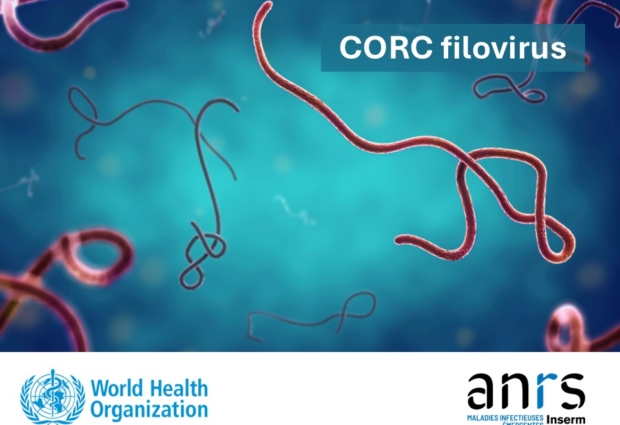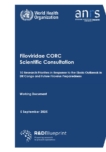
Fighting epidemics: ANRS MIE leads WHO filovirus CORC
Last updated on 29 September 2025
In brief
- The Collaborative Open Research Consortium (CORC) is an innovative WHO initiative designed to develop rapid responses to infectious diseases outbreak.
- ANRS Emerging infectious diseases (ANRS MIE) has been appointed by the WHO to lead the CORC dedicated to filoviruses
- In collaboration with the WHO and other international partners, ANRS MIE is leading global consultations and coordinating international scientific efforts to anticipate and respond rapidly to outbreaks linked to filoviruses such as Ebola and Marburg.
A context of increased epidemic risk
Since the end of the 1990s, the national, regional and global epidemic and pandemic context has undergone several changes. These include an acceleration and increase in epidemic episodes, coupled with a wider spread of these infectious outbreaks.
In this framework, research plays a fundamental role in anticipating these epidemics by strengthening surveillance systems, but also in providing rapid and effective responses to epidemic outbreaks by facilitating the development of new diagnostic methods, medical countermeasures (vaccines and treatments) and public health measures.
The WHO’s scientific framework for pandemic preparedness and response emphasises a comprehensive approach to research and development. By focusing on entire pathogen families as well as priority and prototype pathogens, the strategy aims to create generalizable knowledge and tools that can be rapidly adapted to emerging threats.
A key action to improve global research collaboration and improve research preparedness and response to epidemics and pandemics is to establish a Collaborative Open Research Consortium (CORC) for each pathogen family.
CORCs: an innovative approach to managing global health threats
What is a Collaborative Open Research Consortium or CORC?
CORCs are Collaborative Open Research Centres designed to strengthen research and preparedness for epidemics and pandemics. The creation of CORCs is based on the experience of the MARVAC Consortium created in 2021, which helped plan and evaluate candidate vaccines during the Sudan virus epidemic in Uganda in 2022.
CORCs bring together experts, academic institutions, industry and public health agencies to coordinate scientific efforts. These consortia promote the open sharing of data, the co-creation of knowledge and the accelerated development of interventions such as vaccines and treatments. The main objective is to ensure a rapid and effective response to emerging health threats.
What are the priority pathogens?
Each of the 8 CORCs focuses on a specific family of pathogens with pandemic potential, including 11 viral families and 5 key bacteria:
- arenaviridae (e.g. Lassa fever),
- coronaviridae (e.g. SARS-CoV-2),
- filoviridae (e.g. Ebola virus, Marburg virus),
- flaviviridae (e.g. Zika, dengue),
- hantaviridae (e.g. Andes virus, Sin Nombre),
- nairoviridae (e.g. Crimean Congo haemorrhagic fever virus),
- Phenuiviridae (e.g. Rift Valley fever virus),
- orthomyxovidirae (e.g. influenza),
- paramyxoviridae (e.g. Nipah),
- poxviridae (e.g. mpox),
- togaviridae (e.g. chikungunya),
- as well as certain bacteria.
The CORCs, which are spread across the world, will be implemented using a decentralised structure that encourages equitable participation by researchers from high, middle and low-income countries, particularly those where pathogens are known to be circulating.
Focus on the filovirus CORC coordinated by ANRS MIE
Filoviruses (link to pathogen page coming soon), such as the Ebola and Marburg viruses, pose major public health risks. The CORC dedicated to filoviruses is part of the WHO’s Strategic Agenda for Filovirus Research Monitoring (AFIRM). It defines a set of research priorities for filovirus diseases over the next decade and will be reviewed by the entire filoviruse CORC during 2025.
Each CORC is coordinated by one or several WHO Collaborating Centres using an agreed approach and common objectives. ANRS Emerging infectious diseases (ANRS MIE) has just been entrusted by the WHO with the coordination of the CORC dedicated to filoviruses, and as such will become a WHO Collaborating Centre.
ANRS MIE, in collaboration with the WHO and affected countries, has already organised several global consultations during the 1st quarter of 2025, due to the epidemic situation in certain African countries, to collaboratively define short and long-term research priorities concerning filoviruses.
Filovirus scientific review
The ANRS MIE has initiated the monthly publication of a scientific review on filoviruses.
Read the scientific reviewEbola in the DRC: 10 research priorities defined by the WHO and ANRS MIE
- Following the declaration of a new Ebola epidemic in the Democratic Republic of Congo, ANRS MIE and WHO brought together experts from the Collaborative Open Research Consortium (CORC) on Filoviruses on 5 September 2025.
- Together, they defined ten research priorities to support the immediate response and strengthen preparedness for future epidemics.
CORC filovirus meetings
Access the minutes and presentations of the CORC Filovirus meetings here.
- 21 January 2025 – Marburg response: building research readiness for a future filovirus outbreak
- 14 March 2025 – First meeting on the update of the roadmap.
Useful links
- A WHO Strategic Agenda for Filovirus Research and Monitoring (AFIRM) – Roadmap Meeting https://www.who.int/news-room/events/detail/2022/03/30/default-calendar/save-the-date-a-who-strategic-agenda-for-filovirus-research-and-monitoring-%28afirm%29—roadmap-meeting
- Marburg response: building research readiness for a future filovirus outbreak https://www.who.int/news-room/events/detail/2025/01/21/default-calendar/marburg-response-building-research-readiness-for-a-future-filovirus-outbreak
- MARVAC Consortium – United in solidarity against filovirus threats- Building research readiness for a future filovirus outbreakhttps://www.who.int/news-room/events/detail/2024/04/04/default-calendar/marvac-consortium—united-in-solidarity-against-filovirus-threats–building-research-readiness-for-a-future-filovirus-outbreak
- An introduction to the Marburg virus vaccine consortium, MARVAC https://journals.plos.org/plospathogens/article?id=10.1371/journal.ppat.1010805

